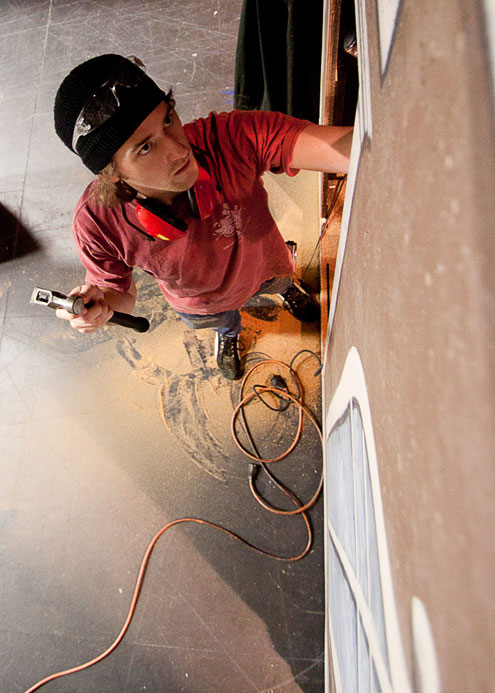After the final curtain has been drawn and a production is brought to its end, the actors take their bow, and the director’s vision is reviewed. However, the weeks of work creating the final on-stage product and those working behind the scenes often go unrecognized.
Productions put on by the University of Alabama’s theater department are a collaborative effort of student actors, workers and UA faculty. Their current production, “An Italian Straw Hat,” which premiered on Monday and runs through March 4, is no different.
“If it weren’t for what we do, you’d have actors on a blank stage in the dark, and they’d have nothing to go on,” said Andrew O’Neal, assistant technical director of “An Italian Straw Hat” and UA graduate student. “We put the actors and the people watching into the play and the story we’re telling.”
After being involved in theater since high school, O’Neal attends production meetings, works in the shop and oversees the construction of sets during his first year with the theatre program.
O’Neal said they began work on the project in early January and putting in extra hours wasn’t uncommon. He said there was passionate and collaborative effort apparent not only in his workers, but throughout the entire production.
“If I can’t build it, painters can’t paint it and then lighters can’t light it,” said O’Neal. “The actors rely on us doing our job and we all rely on each other.”
Leanna Scotten, a graduate student and scenic and prop designer for the play, spends her time in the memorabilia and prop coated shops hidden backstage. Scotten said she has acted on stage since she was 5 years old, but when help was needed backstage during her high school productions, she said it fit her nicely.
“You can look at something like [this partition I’m painting], and it’s something real,” Scotten said. “It’s something I’ve created artistically with my hands.”
Scotten said this particular production required a great deal of painting and coordination between all members of the crew and the director. She said it’s critical to communicate with a director, understand his view of the setting and feel for the characters and then create props and backdrops that are cohesive with the characters and actions on stage.
Scotten said if each piece they create is artistically and thematically unified, the crew’s work goes unnoticed to an extent, but brings out the life behind a play.
“Sitting in the audience and looking at what you’ve created is something special,” Scotten said. “Seeing people’s faces and seeing their absorption in the play is all the appreciation I can personally ask for.”
Haley Carnes, a freshman majoring in theater, was assigned to work on the production as part of her required theater practicum class. Carnes said she found a new appreciation for the variety of odd jobs, from painting all day to simply acting as a level she’d been assigned.
“I’ve really enjoyed it,” Carnes said. “I’m almost done with my required hours, but I think I’ll be back.”
She said she discovered how essential design is to a production and how the minutia of set design could pay off in a big way. Carnes created a purse with the phrase “I love bingo” on it and was surprised at its inclusion in the plot after working on her first play last semester.
“I definitely have a ton more respect for backstage workers,” Carnes said. “It’s hard, and every day, there’s a ton of work, and it all adds a lot more depth to the show.”
Bridget Winder, a junior majoring in musical theater, plays the role of Helen in the play and said not every audience member is aware of the amount of time and effort put into every bit of a show. She said her own challenge – learning her character, researching the period and details such as a characters gait or manner of sitting and then memorizing a script – is always a massive and difficult undertaking.
“People don’t really know the physical, mental and emotional effort that actors have to endure to put on a show,” Winder said.
According to her, the experience she’s had with the program teaches and requires cooperation and respect from both actors and crew members. Winder said crew members’ hard work equals that of the actors and can make or break a show. When their relationship is seamless, it takes a play to another level.
“That’s the beauty of theater that people don’t see,” Winder said. “There’s a magic backstage that brings it to life.”









